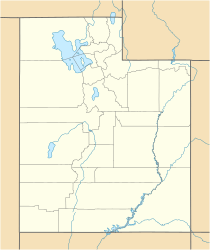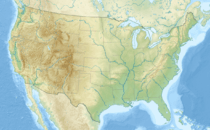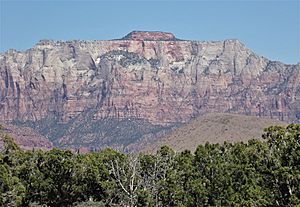The West Temple facts for kids
Quick facts for kids The West Temple |
|
|---|---|
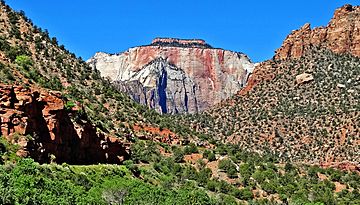
East aspect of The West Temple
|
|
| Highest point | |
| Elevation | 7,810 ft (2,380 m) |
| Prominence | 1,680 ft (510 m) |
| Isolation | 10.66 mi (17.16 km) |
| Geography | |
| Location | Zion National Park Washington County, Utah United States |
| Parent range | Colorado Plateau |
| Topo map | USGS Springdale West |
| Geology | |
| Age of rock | Jurassic |
| Type of rock | Navajo Sandstone |
| Climbing | |
| First ascent | 1933 |
| Easiest route | class 5.6 climbing |
The West Temple is a very tall mountain, standing 7,810 feet (2,380 meters) high. It is located in Zion National Park in Utah, United States. This impressive mountain is made of a special type of rock called Navajo Sandstone.
The West Temple is the highest point in Zion Canyon. Long ago, the Southern Paiute people called it "Temp-o-i-tin-car-ur." This means "Mountain without a trail." Later, local settlers called it Steamboat Mountain. In 1934, the USGS officially named it The West Temple. This name was given by John Wesley Powell during his explorations in 1872.
The West Temple is a famous landmark in the park. It is about two miles northwest of Springdale, Utah. Rain and melting snow from the mountain flow into streams that lead to the Virgin River.
Climbing The West Temple
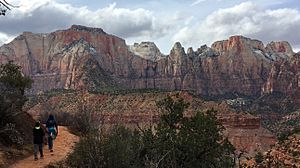
Climbing The West Temple is a big challenge for experienced climbers. The easiest way to climb it is rated class 5.6. This means it's a difficult climb that requires special skills and gear.
Some of the known climbing paths on The West Temple include:
- Southwest Ridge - class 5.6 - This route has 10 sections, called pitches.
- Back Where It All Begins - class 5.11a - This route has 16 pitches.
- Big Lebowski - class 5.11a/b - This is a very long route with 21 pitches.
- Lovelace - class 5.10 - This route has 9 pitches.
- Big Lie - class 5.10+ - This is a shorter route with 2 pitches.
How The Mountain Formed
The West Temple is made of different layers of rock. The top white cliffs are mostly Navajo Sandstone. Sometimes, you can see reddish stains on this rock. These stains come from hematite, which is a type of iron oxide. This iron oxide comes from the Temple Cap Formation rock layer at the very top.
Below the Navajo Sandstone, there are other rock layers. These include the Kayenta Formation, Moenave Formation, Chinle Formation, and Moenkopi Formation. Each layer tells a story about how the land changed over millions of years.
Weather Around The West Temple
The best times to visit The West Temple are during spring and fall. The area has a Cold semi-arid climate. This means it's a desert climate, but it can get cold in winter.
The region gets less than 10 inches (250 mm) of rain each year. Snowfall is usually light during the winter months. Most of the rain happens in spring and summer.


